- Otterbourg Appoints Six as Equity Members, Most in Firm’s History; Three Promoted to Counsel
- Cahill Announces Julie L. Cohen as Firm’s First Chief Marketing Officer
- Jennifer Wallace, Chair of SFNet’s 40 Under 40 Awards, Encourages Members to Nominate Rising Stars
- Gordon Brothers Completes Big Lots Purchase & Facilitates Going Concern Sale
- eCapital Acquires LSQ to Expand Technology Solutions and Strengthen Market Leadership
How Does a Business Deal with Labor Issues in 2022?
February 7, 2022
By Juanita Schwartzkopf
As companies and lenders evaluate performance risk and expectations for 2022, the trends previously considered to be emerging need to be considered a permanent part of the 2022 business environment. At this point, it is unrealistic to expect ready access to employees with necessary skills and to expect salary levels to reduce to earlier levels. Businesses will need to develop tools to plan for and manage through labor shortages in staffing and skills, and increased labor costs. In this article we will first review the labor indicators, and then discuss approaches business management can take to survive and thrive in this environment.
Labor Issues
The labor market is continuing to be problematic for businesses. The December unemployment rate was 3.9%, which shows a continuing improvement over the 4.2% reported in November and the 4.6% in October 2021. The labor participation rate in November and December was 61.9%, which is also a slight improvement over 61.6% in October. The good news is that the overall labor situation did not become worse in December, but the bad news is there is a long way to go to return to the pre Covid-19 performance levels. The unemployment rate is continuing to reduce from the peak Covid-19 shut down levels. However, the labor participation rate is not increasing back to the pre-Covid-19 levels.
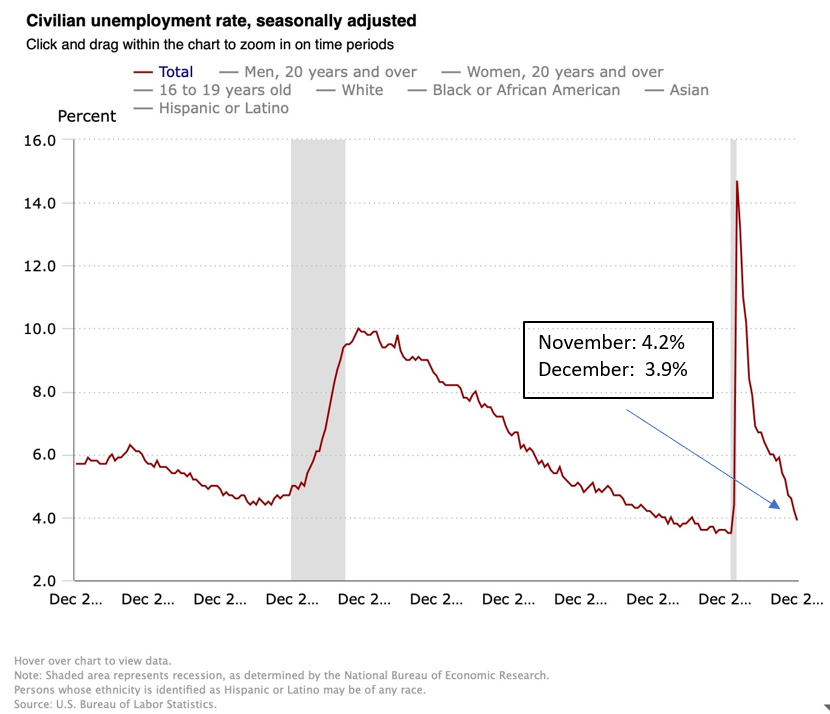
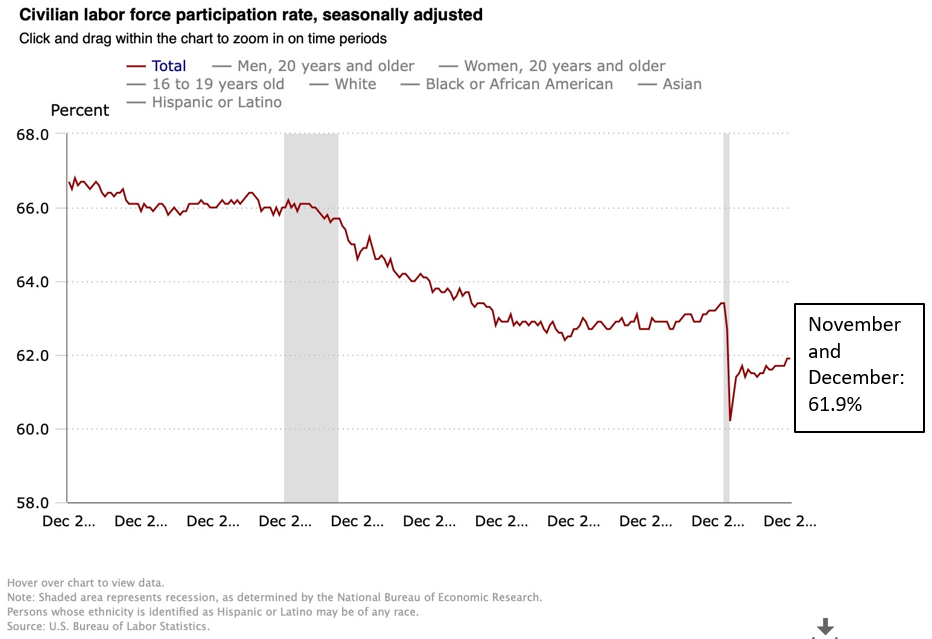
The number of unemployed persons per job opening in September, October and November was 0.7. This is the lowest level since at least 2006.
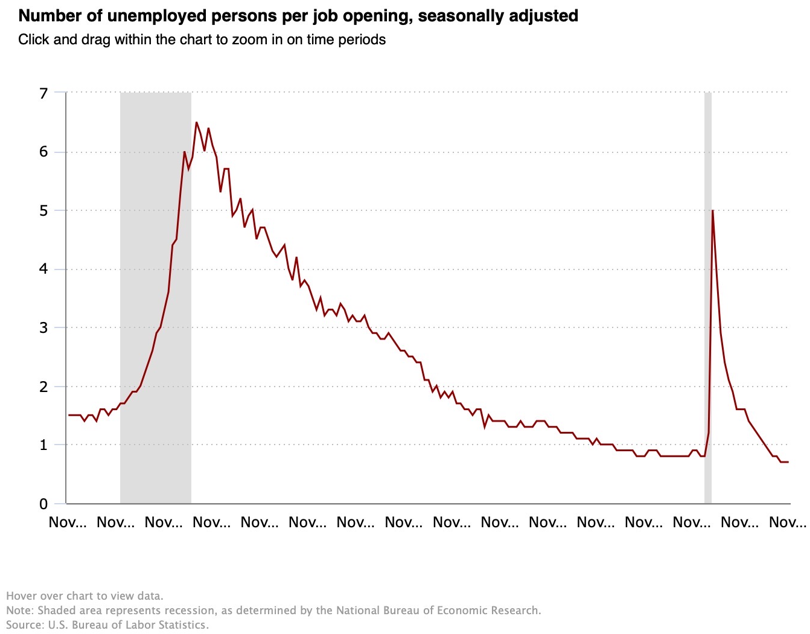
What does this mean to labor costs?
Looking at state by state unemployment the data shows the lowest unemployment rate of 2.1% in Utah, and the highest unemployment rate of 6.9% in California. The next graphic shows unemployment rates by state.
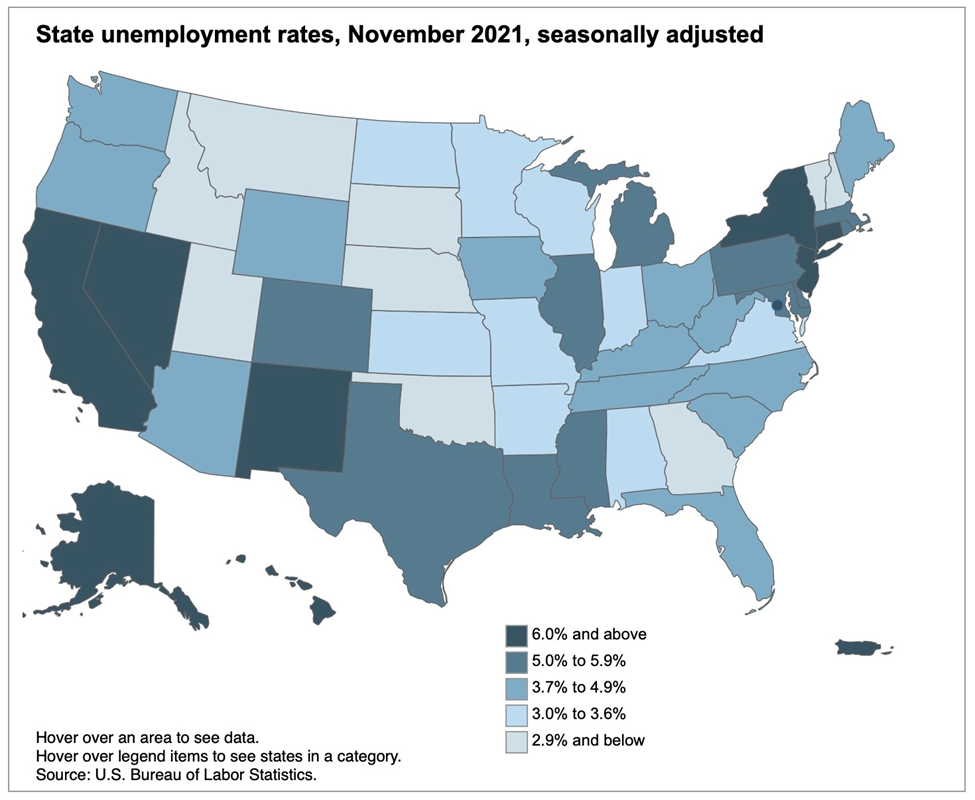
The state or region a business is operating in has a direct impact on the availability of labor and the cost of that labor. The same type of business operating in different geographic regions will have a higher or lower labor issue impact.
To better understand the impact of labor costs, looking at year over year per employee earnings by industry provides additional insight. In the next table, the average hourly earnings and average weekly earnings per employee by industry is shown for October, November, and December 2021, with a year over year comparison of December 2020 to December 2021.
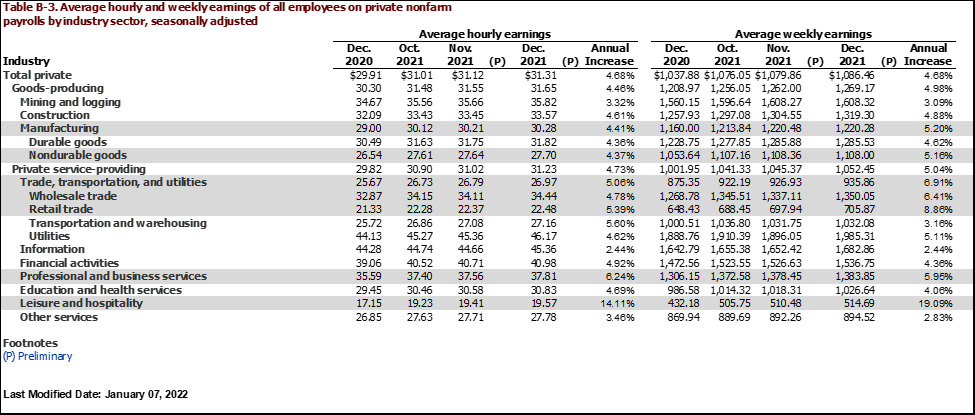
This chart reports average hourly earnings and average weekly earnings. When the weekly earnings increase at a different rate than the average hourly earnings, that is an indication of the hours per week an individual employee works.
The industry sector with the highest growth using both the hourly and weekly measures is leisure and hospitality. The average hourly rate increased from $17.15 per hour in December 2020 to $19.57 per hour in December 2021, a 14.11% increase. Looking at average weekly income per employee, the rate increased from $432.18 per week in December 2020 to $514.69 per week in December 2021, for a 19.09% increase.
Another industry sector that experienced wage increases equal or greater than the December 2021 CPI of 7.0% was retail trade which had a 5.39% hourly rate increase and an 8.86% weekly pay increase.
Industries that experienced annual weekly pay increases greater than 6% were services trade, transportation and utilities, and the subcomponent wholesale trade.
Other industries that experienced annual weekly pay increases greater than 5% were manufacturing and professional and business services.
When comparing financial performance, it is expected that a comparison of 2021 results to 2019 results is a better indicator of the future prospects of a business. Expanding the wage analysis to compare December 2019 to December 2021, results in the following chart. This chart shows hourly and weekly income for December 2019, December 2020, and December 2021, and then calculates the increase from December 2019 to December 2021.
The lowest two-year increase in hourly earnings and weekly earnings was in mining and logging, with a 3.50% hourly increase and a 1.68% weekly earnings increase. Wages for all other industry sectors were up at least 6% over the two years.
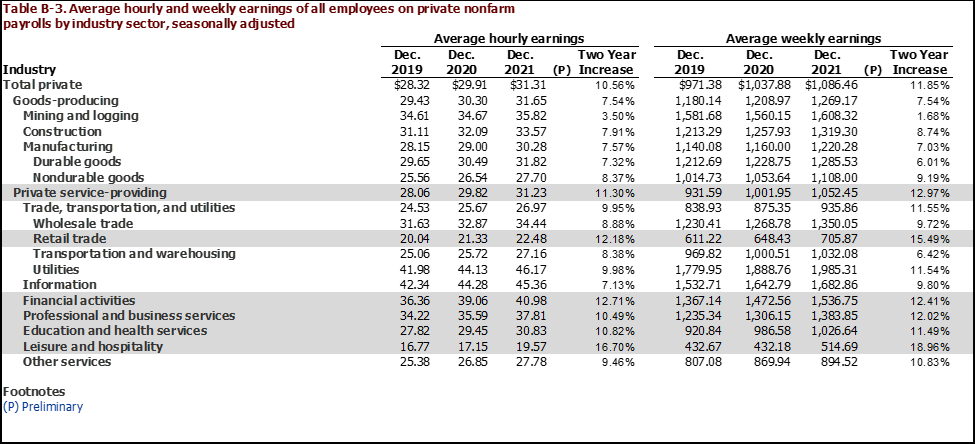
The industry sector with the highest two-year increase was leisure and hospitality (18.96%), followed by retail trade (15.49%) and private service providing trade, transportation, and utilities (12.97%). Financial activities, professional and business services, and education and health services also reported increases in the 10% to 12% range.
Based on this data businesses are experiencing labor cost increases of at least 6% over 2019, with many industry sectors experiencing even higher labor cost increases. Within an industry, the unemployment rate by state data shows that specific states have fewer potential employees to select from.
Furthering this analysis to educational level achieved provides additional insight into the potential skills gap businesses are dealing with. The next graph shows the unemployment rate by educational attainment.
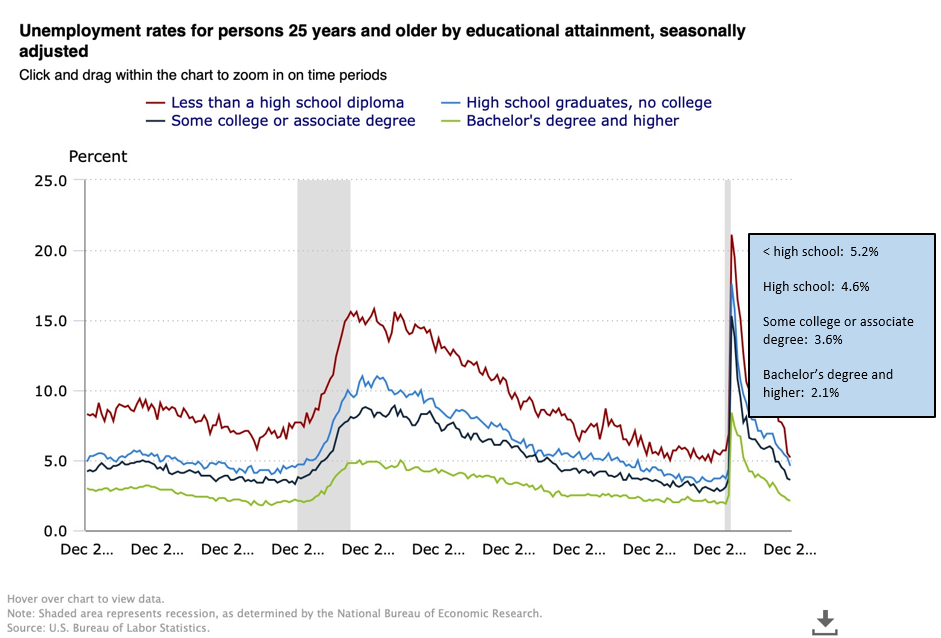
Businesses that require some post high school education are experiencing a smaller labor pool from which to select employees, but even employers that are able to teach skills to employees with a high school degree or less are having more difficulty finding people to work.
Overall, the number of potential employees, the skill set of those employees, and the geographic location of the employer are all working together to stress the financial performance of businesses.
Potential Cost Impact
Labor costs are often the single largest expense category, other than the raw materials needed to produce the product in manufacturing or the purchase of the product for sale in retail. Using 2019 performance as the base, and applying a 5%, 10% and 15% increase in labor costs, the EBITDA of a business can have a negative impact from which it is difficult to recover. Assuming a company with $50 million of annual revenues in 2019, if everything but labor stays at the same cost relationship to sales, the EBITDA of this business could decrease from $3.5 million to $1.9 million, with EBITDA as a percent of revenues reducing from 7.00% to 3.89%.

This analysis should be further developed to consider overtime levels and cost impacts. Employee turnover rates will also need to be evaluated as new employees are typically less efficient than experienced staff members.
Labor costs have increased across the economy; therefore, businesses will need to anticipate increases in other expense line items that are driven by the supplier’s labor challenges. As a result, the impact of increasing wages will be felt in expense categories far beyond labor and benefits of the company being evaluated.
Next Steps
It will be important for business management to move past the excuse of labor shortages or labor issues and develop an analysis and a plan to deal with staffing problems, concerns, and costs. Management needs to ask questions of the management team and challenge the team to anticipate issues and plan for solutions. A management meeting where the discussion topics are labor’s impact on financial performance is an important first step. Here are some examples of questions.
- Evaluate labor costs and personnel availability by location.
- Evaluate skill set availability by location.
- Analyze overtime by location and by department.
- Analyze employee turnover by location and by department.
- Consider ideas to increase pay rates without increasing base pay for the full amount of the increase.
- Performance related bonuses on a frequent basis.
- Bonuses tied to length of time working for the company. For example, a 2-year bonus or a 5-year bonus.
- Consider ideas to increase benefits in ways that employees like, but the benefits may not be as significant to the financial performance of the business.
- Lunch on Monday.
- Tuition reimbursement.
- Consider consolidating locations in areas that have better labor availability and access to needed skills.
- Prepare a cost benefit analysis of emphasizing automation.
- Consider ways to reduce the need for employees while maintaining customer satisfaction.
- Re-evaluate return on investment time horizons with the view to the labor issues.It may make sense to invest in automation that has a longer recovery period due to the labor and / or skill shortages being experienced.
This is a time to emphasize best practices. Management cannot accept the excuse of labor issues. The entire management team needs to engage in strengthening their analysis tools to respond as quickly as possible to labor shortages, skill shortages, and cost increases. This labor environment should not spell doom for companies. The lack of planning and development of a timely response to labor issues is what translates to doom.
Most business managers today have never experienced the labor issues of today. This is the lowest labor participation rate the US has experienced in at least 20 years. The number of people looking for jobs compared to the number of available jobs continues to be below a 1:1 ratio. The last time the ratio between number of people looking for jobs and the number of available jobs was at 1.0 or higher was March of 2018. These ratios do not consider the skills gap, which we are seeing in the reducing unemployment rate for all educational achievement categories. The unemployment rate for the educational achievement categories tracked by the Bureau of Labor Statistics (“BLS”) shows unemployment rates nearly as low as those experienced during the economic boom the US enjoyed before Covid-19 impacts, and the unemployment rate for individuals who did not graduate from high school is lower than the pre-Covid-19 levels.
These labor issues will not be solved by ignoring them and hoping for a better outcome. To thrive in this environment, management needs to analyze and plan. Helping management deal with stress and uncertainty will be important for achieving performance goals for 2022 and beyond.



